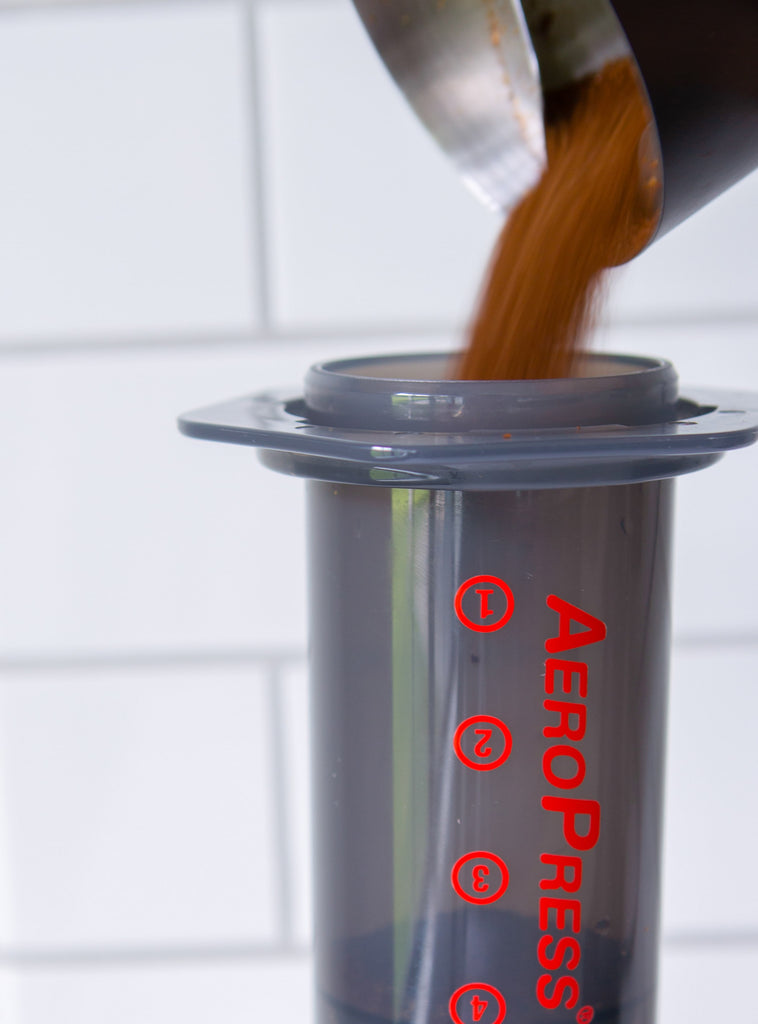The AeroPress’s best attribute is also what makes it difficult to master—the nearly infinite possible brewing variations.
Alan Adler, the founder and CEO of Aerobie, invented the AeroPress in 2004. His goal was to design a device that could brew a superior cup of coffee. In short, he succeeded! Adler created a device that is compact, durable, and frankly, a hit. Folks love the AeroPress!

6 Fundamentals of Brewing
When making coffee, there are six main variables that we can manipulate and control to improve our brew. If you take a look at the recipes from past years of the AeroPress World Championship, no two winning recipes are identical, and contestants toyed with every single brewing variable to make the best cup possible. We’ll highlight each variable and then discuss how it applies to the AeroPress.
1. Coffee-To-Water Ratio
The first variable to consider is the coffee-to-water ratio. In other words, how much coffee should we use compared to how much water? The standard ratio for most methods is around 1:16 (1 gram of coffee for every 16 grams of water), but when it comes to AeroPress, folks like it stronger – the original AeroPress recipe recommends 1:6! After the brewing process is complete, you can add water to taste, but it’s supposed to be reminiscent of espresso. Most alternative AeroPress recipes call for ratios in the range of 1:12–1:16, but rarely much weaker than that.
2. Grind Particle Size

The second variable to consider is the grind. Once again, the standard AeroPress recipe is quite different than other methods. AeroPress recommends a super fine grind—almost as fine as you would use with espresso. Paired with a short brew time, this kind of grind works best. Yet, for variations that involve a longer immersion, we’ll need to go coarser. Medium-fine to medium-coarse is standard. When in doubt, we would recommend starting in the middle of your grind options (a five on a scale of 1–10) and make adjustments based on taste.
3. Brew Time

Time is the third variable. Short brew times are pretty much the norm with the AeroPress. Even with the inverted and immersion variations, AeroPress brew time is usually in the 2–3 minute range. Brew time will largely depend on the grind of your coffee. The finer your grind, the shorter the brew time. The coarser your grind, the longer the brew time. In the recipe we recommend, you’re in complete control of this variable because you get to choose when to flip and press from an inverted position. That’s pretty cool and convenient!
4. Turbulence
The next variable is turbulence. Basically, how much the coffee and water move around together. Generally, more turbulence means more extraction of the coffee, or more flavor. Turbulence also helps ensure that all the coffee gets uniformly wet. In an AeroPress recipe, it’s common to add significant stirring to the brewing process. Just keep in mind that this is a difficult variable to measure. How many stirs, how aggressive, the tool you’re using to stir, and the duration of stirring all impact turbulence. Achieving consistent results depends on repeating your process.
5. Water Temperature

Water temperature gets a lot of attention in an AeroPress recipe. The standard brew temperature for coffee falls in the 195–205˚ F range. The recommended AeroPress recipe calls for an extremely low temperature—around 175˚ F. This is a significant change that, we feel, doesn’t give us the best results. Coffee brewed at these lower temps tends to taste flat, with very little acidity. Sweet and strong are certainly possible, but it isn’t very nuanced. Try brewing across a range of temperatures for yourself, and see what you prefer.
6. Water Quality
The last variable—water quality—is a blog for another time. It gets very complicated! We recommend filtering your tap water to remove flavor and odor. There’s plenty more to know about water quality, but we’ll leave that for a future discussion.

Our Favorite AeroPress Recipe
- 18 g of coffee
- 210 g of filtered water
- Medium-fine grind (four on a scale of 1–10)
- Water temperature at 205˚ F
- Turbulence is a 10-second stir after a 1-minute bloom
- Total brew time ~2:00
- Use three filters, rinsed with warm water
This recipe uses a 1:12 brew ratio and we’ll be using the inverted brew method.
- Heat your water
- Prepare your AeroPress by inserting the plunger about 2cm into the chamber.
- Leave the cap off for now with the filters in it ready to go and set the AeroPress down on the scale, plunger side down.
- Put your ground coffee into the chamber.
- Start your timer when you pour in the filtered water. Be sure to add all of the water at once.
- At the one minute mark, stir for 10 seconds and then place the cap on top of the AeroPress and lock it into place.
- At 1:30, flip the AeroPress over (carefully!) atop your cup and start to press into it. Press slowly so that the last bit of liquid leaves the AeroPress at about 2 minutes.
- Enjoy!
This recipe incorporates all of the previously mentioned variables. Each variable is interdependent of the others, so changing one might mean you need to change something about another to get a pleasing result. Try our recipe, experiment with your own, and let us know how it goes!








